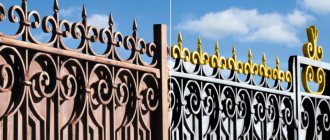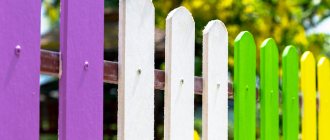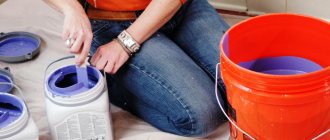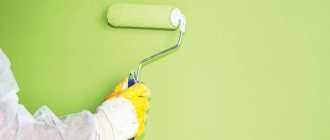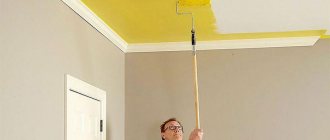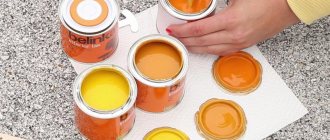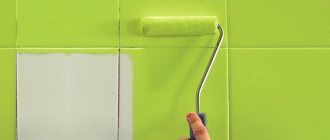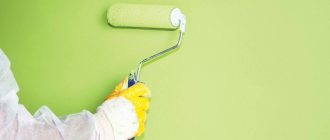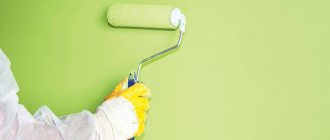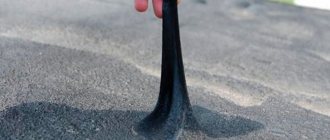The paint and varnish industry is currently experiencing rapid growth. The huge range of varnishes and paints on offer can cause bewilderment and confusion among consumers. You can choose a base for glossy paper, for furniture, ceilings, floors. Each type of color has its own positive and negative characteristics; it is important to approach the selection of coating responsibly and take into account its performance characteristics.
Choose paint: glossy or matte
When choosing paint for the walls and ceiling of a room, you need to be guided by the following criteria:
In any case, owners will need to make a choice between matte and glossy paint. Gloss refers to the ability of a coating to reflect light. It is important to understand that the degree of gloss can be very different! Paint categories according to the degree of gloss created vary from 0 to 100%. 3% is a very matte surface that practically does not reflect light. 30% is already a semi-gloss effect with a noticeable but subdued shine; such paints are called silky matte. Paints in the 50% category are already considered glossy, but with varying degrees of gloss.
Gloss paint is more than just a shiny effect. It is stronger than matte! This must be taken into account. Gloss paint contains more polymer resin. Therefore, it is resistant to moisture and can easily withstand washing with soft sponges and can withstand heavy loads. If you use matte paint in a room with high operational load, which will have to be washed frequently, you can get the following troubles:
Despite such disadvantages, matte paint has the most important advantage - it hides surface defects well. Glossy paint will only highlight the slightest errors made in the process of leveling the walls with plaster and putty.
Designers give the following tips for choosing matte and glossy paint for walls:
Source
How to work with gloss?
Preparing the surface for painting includes the following steps:
- removal of old coating;
- sanding with sandpaper;
- filling of gaps, cracks, joints;
- cleansing;
- primer.
The appearance of the future glossy coating depends on the quality of the preparatory work, so special care and leisure are required.
After this, paint is applied to a perfectly flat surface in one or two layers: with a brush in the corners, with a roller on large areas or with a spray on a small area or individual parts.
The enamel is applied to the primed surface in one layer.
Thus, glossy paint can be considered an economical material: a liter of material is enough to paint about ten square meters.
Matte paint is considered a good solution for painting walls: with its help it is possible to hide small defects on the surface. Semi-matte is well suited for rooms where wet cleaning is often carried out. Before carrying out repairs, you need to familiarize yourself with the properties of the material used for painting.
Painting the walls. How to make the finish perfect?
One of the modern interior trends that is confidently gaining popularity is wall painting. It would seem that monotony is quite boring, but most designers are right in their unanimity: painted walls serve as a neutral canvas for expressing style in details, furniture and accessories and look much better than a repeating finished pattern. At first glance, this is the simplest type of decoration, but there are features in painting walls that need to be taken into account.
Today, together with specialists from Meffert AG, a manufacturer of düfa paint and varnish products, we will talk about what paints are now in fashion, how to prepare a base for them, and which coatings forgive flaws and which require an ideal surface.
Combination with other materials
In the interior, 2-3 types of wall decoration are often used to diversify the design.
Wallpaper and painting
They can be combined in the case of finishing the ceiling with wallpaper and the walls with paint, creating an accent on a painted wall, or combining bottom - paint, top - wallpaper. There are also special paintable wallpapers that can be repainted several times.
Photo wallpaper and painting
Used in the kitchen, hallway and toilet. The walls are exposed to moisture, so photo wallpaper is used for decoration.
In the photo there is a bedroom interior with photo wallpaper and neutral walls, the podium serves as a closet.
Plastering and painting
The plaster can be painted on top of the bark beetle, which will give relief to the walls, or combined with painted adjacent walls in the interior of the toilet, kitchen and hallway.
Wood and painting
A wooden wall made of beams or laminate is combined with plain wall painting in the interior of an attic, living room, or country house.
Stone and painting
Suitable for decorating a fireplace wall in the interior of a living room, country-style kitchen or chalet, where the apron is made of piece stone and the rest of the walls are painted in a single color or a transitional color. Brick and painting are suitable for finishing a kitchen in Provence or loft style.
Brick and paint
The brick can be white or red, and the paint can match the brick, or differ in color.
The photo shows an eco-kitchen with olive walls and a brick partition.
3D panels and painting
3D panels are suitable for simple but unusual interior design. Plain walls with volumetric panels are suitable for a discreet and stylish design, and two-tone painted walls with colored panels look good in a nursery or in an abstract interior.
Matte or glossy?
Choosing interior paint is a multifactorial process that includes several stages:
Most painters know about these factors, but the average buyer is usually not aware. This can cause serious disappointment and disputes about the quality of the paint job.
Depending on the ratio of the above factors, a specific brand of paint with the appropriate gloss level is selected. Why is gloss so important?
The gloss category has a numerical value - from 1 to 100. This number means the % of glossy effect on a given surface. For example, “2%” is a very matte effect, and “20%” is a “semi-matte” effect, also known as “silky matte” or “semi-gloss”.
But gloss is not only shine. This indicator directly affects the wear resistance of the paint. The whole point is that the amount of polymer resin in glossy paints is higher than in matte paints, where pigments and fillers predominate. The high amount of resin allows the paint to shine and be resistant to moisture. The coating formed by glossy paint is easy to clean and easily withstands serious loads (washing, grinding, aggressive and heavy pollution).
In contrast to glossy paints, matte paints are not recommended for surfaces that are prone to contamination and require frequent cleaning. Therefore, they are usually used for ceilings and walls in rooms with low operational load.
The use of matte paint in situations that do not correspond to the tasks of the room can lead to such unpleasant moments as:
However, matte paint has its own significant advantage - it is the ability to hide minor surface defects. In addition, matte paint, especially in light colors, is the optimal choice in difficult lighting conditions, when light glides over the painted surface and highlights the slightest defects. While glossy paint will only highlight small scratches or unevenness.
Using glossy paint where matte paint should have been applied is also fraught with unpleasant consequences, and here is a striking example from our forum:
Today, modern industry produces variants of matte or semi-matte paints that combine a good surface masking effect with high wear resistance.
For example, there is such a category of paints as “Mattlatex” or “matte latex”. This type of product came to the domestic market from Germany. This is, in a way, already a classic of the genre among typical German interior coverings. And today, German painters predominantly choose coatings of this “masking” nature. The word “matte” promises the experienced consumer a flat surface in visual perception, and “latex” (that is, a kind of adhesive base) promises special strength and wear resistance. The latest trends in the development of the paint and varnish industry are associated with the introduction, in addition to the traditional latex binder, of new, innovative materials: especially resistant dispersions, waxes, fillers and pigments of an increased reliability category. Such paints may include elements of nanotechnology, industrial ceramics technologies, and microcrystalline marble filler, forming surfaces of particular durability and reliability.
bathhouse design project inside photo plan
In our product line, the level of strength and intensity of gloss are correlated with the digital indicator in the name and correspond to the percentage of gloss on the surface.
Thus, the issue of choosing paint is a complex task that includes a serious set of measures, and simply choosing a very expensive paint in itself does not guarantee an excellent result. A lot depends on the preparation of the base.
Types of interior paint products
Acrylic paints come in several types. Some are intended for finishing and construction work, others are for painting metals, and others are used by artists and painters.
Acrylic glossy paint for walls
Creates a beautiful appearance and a more durable coating compared to matte counterparts. Recommended for use in rooms with high humidity. Visually expands the space of the rooms, but at the same time makes visible imperfections and unevenness of the walls.
Matte water-dispersion
Does not fade over time, maintaining its original appearance. It is effective in painting uneven walls, as it hides minor imperfections.
Glossy
It looks expensive and impressive. Popular for painting walls and finishing ceilings. Look great in modern and progressive interiors. Metal and glass furniture pieces fit seamlessly into rooms with a glossy finish.
Water-based acrylic
Produced on a water basis. Differs from analogues in increased water resistance. The coatings look rich and beautiful due to the addition of pigments.
Pearlescent interior acrylic wall paint
Gives the wall a unique look.
The material contains a pigment that helps refract sunlight. Therefore, in different lighting conditions and at different times of day, the walls look special.
Pearl effect paint is easy to apply to any surface and can be used in tandem with wood trim, liquid wallpaper and painted drywall.
Preparing the base
Preparing the base for painting includes a certain set of works, the strict execution of which is designed to ensure the best quality of the surface. For example, the level of preparation that is suitable for wallpaper is completely unsuitable for painting. Moreover, even painting with paint with different effects requires a different approach in each specific case.
The surface quality at different stages has different tolerances.
The use of clear standards in surface preparation in itself implies not only a high level of organization of the finishing process, but also facilitates control of the work. Visually, the quality of the surface is controlled using special flat lamps. With contrasting lighting, the flow of light is directed along the walls. If irregularities (bumps or depressions) are noticeable, it means that the surface requires additional putty.
The trend for smoothness and uniform surface finish dictates its requirements in relation to preparation:
From surface preparation, let's move on to an equally important and interesting issue: the choice of application method.
Specifics of acrylic paints
For glossy acrylic materials, acrylic resin is used as a binding element. Such paints have high elasticity, strength, and are suitable for wooden surfaces.
Attention! Using glossy acrylic paint, you can cover hairline cracks up to 0.5 mm in size.
Disadvantages of such materials:
- high price;
- cannot be used in buildings with damp walls.
Analogs are made from acrylic copolymers that have less attractive performance characteristics.
Advantages of acrylic paints:
- frost resistance (subject to complete drying);
- low gas permeability (protect the material from corrosion);
- personal coloring;
- resistance to ultraviolet irradiation;
- vapor permeability;
- mechanical resistance.
Mechanized versus manual labor
It is no secret that today in most cases the manual method of applying interior paint to walls using rollers is used. This is understandable if we remember our earlier statement that most people consider painting one of the simplest ways to decorate walls, why unnecessary mechanization?
However, applying paint by spraying has a number of certain advantages:
Glossy floor technology
The installation technology seems quite simple in appearance, but it is important to carry out all work carefully and carefully. The slightest mistake and it will be very difficult, if not impossible, to correct the situation. The filling process is done like this.
Step 1. Preparing the base - this is where all the work begins. It is important to pay particular attention to this step, since it is the self-leveling (and even more so glossy) floor that must be laid on the prepared subfloor. All debris and dust are removed from it. The latter can hopelessly ruin everything!
Preparing the base
Step 2. Most often, the base is a regular concrete screed. It may be covered with cracks, and the glossy coating, after drying, will definitely “give out” them all and present them to the eyes of the guests. To prevent this from happening, all cracks are carefully sealed, and the tubercles are sanded. At the same time, if the screed has hopelessly lost its appearance or is all cracked, it is completely dismantled and refilled with a new one. Fresh screed is dried for at least 28 days. A gypsum mixture can be used to seal cracks. Large potholes are filled first, followed by smaller ones.
Gypsum mixture for filling cracks
Sealing cracks
Attention! Even microcracks should be repaired, since a glossy surface will not be able to hide them. Unless you use a large amount of the mixture, but in this case the cost of finishing the floor increases significantly.
Step 3. The floors are once again cleaned of dust and debris. A vacuum cleaner is an ideal assistant in this case. All joints and corners are especially thoroughly cleaned.
Cleaned rough base
Step 4. Next, the surface is primed. The mixture must be thoroughly mixed, for which you can use any tool or stick.
The primer mixture is mixed
On a note! Before priming, the surface can be sanded. This will increase the adhesion between the base and the compounds by opening the concrete pores for deeper penetration of the soil.
Step 5. The primer is poured onto the floor and carefully leveled with a wide spatula. By the way, the base can be primed in several layers. Thanks to this, the surface will be more durable, dust-free, and sealed.
Applying primer to the base
Step 6. About a day after applying the last layer of primer, the floors are vacuumed, and masking tape is applied along the joint between the wall and the floor.
The perimeter is covered with masking tape
Step 7. After this, in strict accordance with the instructions, the composition for the self-leveling floor is mixed with the hardener. Mixing is done using a construction mixer or a special attachment for a hammer drill.
Preparation of the composition for self-leveling floor
A construction mixer is used for work.
Step 8. Next, the finished mixture is poured over the base and leveled. Leveling is done using a squeegee. At the same time, you can move on the floor only with paint shoes, so as not to spoil the surface.
Pouring the finished mixture
Leveling the mixture
Using a squeegee for self-leveling floors
Step 9. To ensure that all the air is removed from the composition applied to the floor, and also to extend the “lifetime” of the solution, the poured floor is carefully rolled with a roller, the surface of which is covered with spikes. Rolling is carried out at least 2-3 times. If this is neglected, microvoids will remain in the dried floor, which will negatively affect its quality and appearance. After the floor has dried, a finishing layer is applied to its surface - a protective varnish.
Rolling the surface with a needle roller
It is important to carry out the work promptly, since self-leveling floors set very quickly. A maximum of 30 minutes is allotted for the entire filling process. Otherwise, it will not be possible to achieve an ideal surface. Filling can also be done in several layers - for reliability. In general, the drying time for such a floor is about a day, but furniture can only be placed on it after 72 hours.
conclusions
Objectively, high-end interior paints are subject to a fairly large list of requirements, not only and not so much aesthetic as operational ones. If we are talking about ease of application, then high-quality paint should have:
But such a list would be incomplete without mentioning the requirements for aesthetics and performance characteristics. Good paint is:
You should always plan your work correctly, familiarize yourself with craft techniques and life hacks, and only after that begin the responsible work of painting, be sure to get your hands on it and test all new materials and techniques on test surface samples. There are many useful topics and articles on this topic on our portal. For example, where do vertical stripes on painted walls come from or how does the sun affect the appearance of defects in a painted surface.
Read about interesting wall painting options in our article.
Source
What tools are needed to paint the ceiling?
What you will need to paint the ceiling:
- ladder;
- bath (tray) for paint;
- paint rollers for doing the main part of the work - “fur coats” with short pile are suitable for glossy paint, foam rubber and velor are not suitable;
- flat paint brushes of different widths for treating hard-to-reach places;
- masking tape (tape) to protect surfaces in contact with the ceiling.
It is better to finish a large area ceiling using a hand-held spray gun. You can rent a machine for mechanized painting. The layer applied by spray is thinner and smoother than when using rollers. The possibility of fibers sticking to the painted surface is excluded.
All about wall paint: main trends, designer tips and ratings 2021
Project by Jana Sochavo. Photo: Zhenya Muravyova
Choosing paint for renovation and interior decoration is always a difficult task. So that you don’t have to spend hours searching for the information you need, we decided to collect it in one article. And, of course, we learned what criteria they focus on and what life hacks designers use when choosing paints.
Go to the section you need
Or read from beginning to end!
Top 3 matte monitors
Introducing monitors with matte displays, which, according to users, have gained popular popularity in 2022.
ASUS ZenScreen MB16ACE 15.6″
This portable monitor with anti-glare coating is designed in an elegant and rather discreet style.
The IPS panel used allows you to appreciate wide viewing angles and high-quality static contrast. The device works great in multitasking conditions and is suitable for business presentations, watching movies and dynamic gaming sessions.
The monitor is equipped with a USB Type-C port, which is responsible for power supply and data transfer. It has sufficient image brightness and contrast.
pros:
- thin body and light weight;
- convenient case-stand;
- fast matrix;
- good factory calibration;
- functional menu;
- excellent equipment;
- energy saving and reliable.
Cons : small coverage of sRGB and Adobe RGB color spaces.
Samsung C24F396FHI 23.5″
The presence of a curved screen allows you to change established ideas about viewing video content.
This shape creates a wide field of view, and the screen appears significantly larger than its flat counterpart. The ergonomic stand allows you to change the position of the monitor, which makes the work process more comfortable.
The introduction of special technologies makes it possible to reduce the level of blue light in order to reduce eye strain, as well as protect the eyes from strain caused by flicker.
pros:
- image clarity;
- original design;
- convenient control;
- eco-energy-saving technology;
- availability of connectors for connecting other devices;
- Possibility of image optimization.
Minuses:
- the stand is not height adjustable;
- uneven illumination.
Philips 273V7QJAB 27″
The 27-inch diagonal matte screen monitor features advanced technology that provides a wide viewing angle.
The monolithic LCD panel is built into an ultra-thin frame, almost invisible at first glance. Special proprietary technology analyzes the displayed content with automatic adjustment of color and backlight intensity. Display performance is optimized for user convenience.
pros:
- large screen;
- fast matrix;
- good picture quality;
- decent color rendition;
- decent viewing angle.
Minuses:
- weak sound from speakers;
- There is no USB port.
What kind of paint is there and what is it suitable for?
By texture
Texture is how we see the surface. It can be smooth, rough, homogeneous, or interspersed with other materials - whatever you like. Based on texture, wall paint is divided into matte, semi-matte, semi-gloss, glossy and textured (for example, imitating plaster).
Now designers most often use matte paint - it looks noble, does not attract unnecessary attention and becomes an excellent background for the interior. However, sometimes a semi-matte or glossy paint may be a better choice. Semi-matte hides wall unevenness better, forgives small flaws and is easier to apply, while the glossy surface is easy to clean.
The matte finish of the paint is a very important aspect. Recently, it has become very fashionable to cover walls with matte paint. But if there are children or animals in the house, we try to dissuade customers from this: traces of any touch remain on such walls. Therefore, we most often use silky-matte paint; it is resistant to wet cleaning.
More and more customers prefer not decorative plasters and “Venetian” plasters, but matte paints with a beautiful shade - I really like it. I will definitely continue to make my choice in favor of painted matte surfaces in 2022.
By composition
For interior work, water-based paints (vinyl, emulsion, acrylic, latex, PVA, silicone), organic solvent-based (alkyd, oil, enamel) or adhesive (casein, dextrinated) are used.
For example, for a nursery or kitchen, you should choose washable paints that will not release harmful substances even when heated. Vinyl or latex coating is suitable.
leveling the floor with your own hands using concrete
For the bathroom you should take special moisture-resistant paint. A good choice is silicate, which is based on liquid glass.
In the bedroom you can use not the most practical, but environmentally friendly options. For example, casein paint is based on protein obtained from milk. Or dextrinated - on bone glue.
To paint walls in residential areas, we always use moisture-resistant, washable paint. For particularly wet rooms, such as a bathroom and toilet, the paint should be of increased moisture resistance. This paint can be safely used in the bathroom in combination with tiles to make the interior more interesting and cozy.
Colorful Glitter: Introduction
When deciding to use paint, you have to make a choice based on several parameters. For example, the surfaces to be painted will be matte or glossy.
Acrylic or any other paint consists of colored pigment and resin. A high percentage of pigment creates a matte surface. The predominance of resins makes it glossy.
Gloss paint in the interior of the house Gloss alkyd paint purple
When the paint dries, the solvent evaporates, the resin hardens, and the remaining glossy paint turns into a durable, water-resistant film coating. Such properties make the glossy mixture preferable in rooms with high humidity or frequent mechanical stress (for example, friction). This is an option for fans of cleanliness who endlessly wipe and launder the apartment.
Although glossy paint finishes are easy to keep clean because dust or dirt doesn’t stick to them well, they are most often chosen for decorating small spaces because the shine visually enlarges the space and the background becomes deeper and more mysterious.
Blue glossy paint Glossy paint on the wall in the living room
Gloss painting, however, requires a perfectly flat surface of the walls or ceiling: the slightest depressions or bumps will be clearly visible. Therefore, the preparatory stage when working with such compositions is the most important.
How to choose a color
Collect references - save your favorite interiors on social networks or on thematic websites.
Consider the lighting - if the windows face north or west, the room will be darker than a room with windows facing south or east. For dark rooms, lighter and brighter colors are suitable; in sunny rooms, you can experiment with dark shades. Equally important is how the space will look under artificial lighting: will it be warm or cold, bright or dim, where the lamps will be located. Cool wall tones can appear dirty in warm lighting, and vice versa.
So that the white color does not seem cold and “sick”, it needs to be tinted a little with yellow pigment.
Make colors and try them on indoors. See how the shade will look on different walls, at different times of day and in different lighting.
We always purchase paints and recommend that everyone do so. Having saved some money on a sample, you may end up with 20 liters of completely unsuitable paint. After all, even a color that you have already used many times in some other interior will not work in a new one, because, for example, a yellow house will stand opposite and cast reflections on your room, “painting” all the walls.
Features of glossy monitor screens
Features of glossy screens are brighter, more saturated colors, high color rendering, and black color is much more pronounced. However, when using a glossy monitor, reflections and glare become more noticeable. Another downside is that when the computer is turned off, all fingerprints are visible. When sunlight hits the screen, the image becomes worse. As a result, it becomes impossible to work on it on a sunny day or outside. Another disadvantage of such a monitor is that they put a lot of strain on the eyes.
Matte screens differ from glossy screens by a special anti-reflective coating that prevents reflection. With a matte monitor, you can work in any conditions and reduce eye strain. The downside of this monitor is poor color reproduction, colors are faded and dull.
Brand rating
To make choosing paint easier for you, we studied reviews and ratings from manufacturers in different stores and on dozens of websites - and this is what we found.
Middle segment
These paints are presented in many Russian stores, are practical and can be tinted in any shade.
Caparol
This brand is rather a cross between the middle and premium segments. The main features of the brand are ideal coverage and special components in the composition that make this paint more durable.
What to take : Caparol Indeko-Plus - a deeply matte paint that forgives flaws and applies perfectly, Caparol CapaSilan - excellent covering properties and durability, Caparol Amphibolin - an almost flawless dispersion paint, looks great and contains a minimum of harmful impurities.
Beckers
This paint applies well, is practical and durable - this is why professional builders love it.
What to take : Beckers Elegant Vaggfarg Matt - latex paint that is ideal for residential premises, Beckerplast 7 - fits perfectly, is durable, with a beautiful finish, especially popular among painters, Beckerplast 3 - has all the advantages of Beckerplast 7 plus perfect matte finish.
Tikkurila
The Finnish brand, which pays great attention to environmental friendliness, is very popular in Russia. Good quality, easy to apply and durable. And there are almost limitless possibilities for tinting.
Help: what is tinting?
Tinting is giving the paint the desired shade when the required amount of dye is added to the working base - white or transparent. You can order tinting from a store or do it yourself (just practice on a small amount of paint first). Each manufacturer has a tinting card, where each shade option is assigned a code - using it, the store will immediately understand in what proportion to mix the colors.
What to take : Tikkurila Euro Power 7 - high-quality and dries quickly, Tikkurila Harmony - in this line the main emphasis is on health safety, Tikkurila Euro Extra 20 - paint with minimal consumption
Dulux
High quality British paint with high hiding power. It is environmentally friendly, safe, easy to use and is available in many Russian stores.
What to take : Dulux Diamond Extra Matt - matte paint that can be washed frequently, Dulux Bindo 2 - latex paint that perfectly hides uneven walls.
Alpina
One of the best German manufacturers (the brand belongs to the Caparol Group), which takes a very responsible approach to its products: all paints are safe and environmentally friendly.
What to take : Alpina Renova - good value for money, durable - retains its original appearance for up to 10 years.
Dufa
Another German brand that specializes in latex paints. The quality is also German: Dufa has moderate consumption and wear resistance.
What to take : Dufa Superweiss is one of the most budget-friendly paints, but the quality does not suffer from this.
Premium segment
With paints from the premium segments, everything is a little different. For example, usually they cannot be tinted at your own discretion, but all the shades presented in the palette are specially developed by leading designers and colorists and will definitely look their best.
Designers Guild
The founder of the brand, cult designer Trisha Guild, herself developed unique shades: neutral, muted, accent and trendy. The paints have excellent hiding power and a washable surface.
the puddle on the floor appeared overnight
Little Greene
Besides quality, Little Greene is, of course, original colors. Some of them are “archive”, developed in the 18th-20th centuries.
Source
Design styles
Modern
The style uses single or two-tone wall painting, combining white with another color. The children's interior uses bright details in stripes and patterns on the wall. The emphasis is on practicality, so an unobtrusive palette and combinations are used.
Minimalism
Minimalism is observed in monochromatic painting, a combination of gray or pale blue with white, and decor with wide stripes. Sometimes contrasting molding or textured paint is used in the interior.
Loft
The interior is not limited to a specific color palette; the design is often used only on an accent wall. Brickwork can also be painted using ombre technology.
Classic
In the interior it is expressed in a neutral light background with golden, white monograms, in blue or black patterns, which are emphasized by tassels and fringe on velvet curtains of emerald or ruby color.
Provence
Provence or the French summer gloss of the interior is recognizable in pink, mint or blue walls, olive shade of curtains and textiles. The walls in the interior can be painted plain or striped. To create individuality, you can make an artistic painting on the wall in the form of an open window onto the summer Provencal fields.
The photo shows a turquoise bedroom in Provence style with monochromatic walls, classic furniture and floral textiles.
Country
The interior uses a combination of natural timber or stone with brown, mustard, white paint with a whitewash texture.
Scandinavian
The interior is as practical and light as possible, so the walls are creamy, white, or less often sandy or blue. Stripes, molding, 3D panels, and a white brick wall are suitable for decoration.
Painting walls as one of the types of finishing is used not only for external but also internal work thanks to paints that are odorless, dry quickly and do not harm health.
How to choose paint for walls: understand the compositions, textures and shades
What to paint the walls in the bedroom, what to paint in the hallway, and what is only suitable for the ceiling, how to choose safe compositions and why you don’t need to chase super-matte surfaces.
Material prepared by:
Vera Rogatko
Painting the walls with high-quality paint in “delicious” colors is one of the most affordable ways to create an expressive interior. And the simplest one, if the situation is boring and you need to update it quickly and radically. We’ll tell you in this post how not to get confused in a salon with hundreds of samples and multi-colored jars when choosing the right paint for the walls in an apartment or private house.
Design: Nadya Zotova
Design: Nadya Zotova
Preparatory work depending on the type of surface
The first step to a flawless painting result is surface preparation. General rules:
- Remove furniture, household appliances, and other items from the premises. Cover heavy items with film. Remove the lighting fixtures.
- Remove old coating.
- Apply primer. It reduces paint consumption and improves adhesion to the surface. The primer is selected taking into account what material needs to be painted, and on the same basis as the paint and varnish. For example: an alkyd enamel was chosen for a concrete ceiling - buy an alkyd primer for concrete.
Drywall and gypsum fiber sheet (GKL and GVL)
Preparing gypsum plasterboard and gypsum fiber board ceilings for painting:
- Using a spatula, move it along the places where the sheets of drywall are attached and push down the heads of the screws on which it will catch.
- Wipe the ceiling with a dry cloth.
- Apply acrylic putty primer to all corners using a brush.
- Apply primer to the entire surface with a roller. After drying, apply a second layer.
- 24 hours after completion of priming, prepare the seams between the sheets for filling with putty. Jointing is often required.
- Cover the joints with putty mixture and seal with serpyanka or reinforcing tape. Apply a second layer of putty to the seams, wait until it dries, and sand with sandpaper.
- Caulk all the drywall. After drying, remove any unevenness with a spatula. Cover the floor and walls with film, put on a mask or respirator, and sand the ceiling with a special grater.
- Apply the second (finishing) layer of putty. The surface should be perfectly flat. Another coat may be needed. After drying, sand the ceiling again with a float or sandpaper with the finest grain. For glossy paint, sand especially carefully.
- Remove dust.
- Apply a coat of paint primer and leave to dry for 24 hours.
Quickly about paints: what you need to know before going to a salon or hypermarket
Paints from the first group (oil-based, alkyd enamels) are diluted with an organic solvent and are mainly intended for external work: they are used to paint the facades of brick, concrete, wooden buildings, garages, fences, window frames and other objects located on the street. They protect painted surfaces from moisture, rotting and corrosion, and do not fade in the open sun.
Sometimes such compositions are used indoors. But it’s better not to do this: for example, an oil coating takes several days to dry, releases harmful toxins during drying, and has a pungent odor that is then difficult to remove.
Paints from the second group (water-based, water-dispersed) are diluted with water, so they have almost no odor, contain safer components than paints based on drying oils, oils and resins, and are optimally suited for interior work.
All water-based paints follow the same principle
Features of painting walls of different materials
Wooden walls
Painted wooden walls not only look aesthetically attractive, but also extend the life of the wood. Before painting, the old coating must be removed from interior doors or walls made of wood and treated with stain. After drying, apply 1-2 layers of alkyd or acrylic paint.
The photo shows a wooden panel painted pale yellow in a classic bedroom interior with a gray baseboard and light floor.
Brick walls
Before painting, they clean and wash with water; after a week, all the moisture will be released and it will be possible to prime the surface and paint the brick with interior acrylic or alkyd paint. You can age the brick or create smudges. You can use a contrasting color for the seam.
Concrete walls
Before painting, you need to clean it, make the surface smooth and free of cracks, prime it, let it dry and apply epoxy or latex. A repeat layer must be applied to the entire surface of the wall at once to avoid changes in shade.
Wallpaper
Paintable wallpaper is convenient in that it can be repainted without driving pigment into the walls. Such wallpaper can also be removed without sanding or cleaning the surface. Wallpaper paint is water-based without solvents. Textured wallpaper makes work easier and hides uneven walls.
Drywall
Drywall on a wall or ceiling is painted after filling the joints and all the drywall, as well as sanding and priming. They use acrylic or silicone paint, which are plastic and create a protective film.
Plaster
Painting on plaster takes place on a clean, dry surface. If chips are noticed during the preparation of the wall, they need to be cleaned and sealed. Painted with a roller in 2 layers with maximum filling of pores.
How to choose wall paint: understanding the key characteristics
Water-based or water-dispersed - what's the difference?
Design: “Workshop of Elena Gorenshtein”
Design: “Workshop of Elena Gorenshtein”
Matte or glossy?
This indicator affects not only the appearance of the surface being painted, but also the practicality of caring for it. Matte walls are the most popular among Russian customers, but there is no need to chase an absolute lack of shine - now we’ll tell you why.
Design: Nadya Zotova
Design: Nadya Zotova
Design: Anna Muravina
Design: Anna Muravina
What colors to paint on the wall?
Design: Elena Karaseva
Design: Elena Karaseva
How to understand that paint is hypoallergenic and not hazardous to health?
Even the most environmentally friendly formulation contains chemical solvents aldehydes, ketones and other volatile organic compounds (VOCs or VOCs). How safe the product will be depends on the concentration of VOCs: according to European standards, the maximum permissible value is 3%, that is, no more than 30 grams per 1 liter.
To determine how much volatile organic compounds are in paint, look for the VOC Label on the can or manufacturer's website indicating the content of these substances. The fewer there are, the better.
It would be a good idea to ask the seller about the availability of international certificates, for example, ISO 9001 (an international standard for quality management), and look for special eco-labels. For paints and varnishes this is:
Which wall paint is better: rating of popular brands
Designers advise giving preference to proven European manufacturers - Benjamin Moore, Little Greene, Farrow & Ball, Argile, Sherwin Williams, Sanderson, Zoffany. Paints from premium brands are better than budget counterparts for several reasons:
Design: Yulia Likhova
Design: Yulia Likhova
Design: Daria Mayer
Design: Daria Mayer
All about gloss
The main and decisive factor when choosing a material for painting is color and gloss. Moreover, if the choice of color is a matter of taste and a design decision, then gloss can influence not only the appearance, but also the stability of the paintwork .
This effect is due to the fact that the paint contains resin and pigment.
Depending on one or another component, an external indicator is obtained, that is:
Important! With a high resin content, the solvent evaporates during drying, resulting in a durable and waterproof coating. That is why the instructions for using such a coating suggest application in rooms with high humidity.
Bathroom wall covering option
Why this option
Despite the fact that gloss is not very common today and the matte version is often preferred, an externally sparkling surface has undeniable advantages:
Important! The glossy surface will instantly show all the defects of the wall. Every bump, every depression will be clearly visible, so the wall must be in perfect condition before painting.
On such a wall any defect is immediately visible
Types of paints
It only seems at first glance that any surface is painted with the same dye, but in practice there are three types of paint:
Acrylic paint for all repairs
Acrylic material does not fade in the sun and, like Zinga conductive paint, does not fade in the sun when exposed to ultraviolet rays.
What to look for when purchasing
Deciding on the type of paint for finishing is not all that is required before purchasing.
There are also technical parameters that must be taken into account:
Wallpaper after painting will be completely different visually
What can be painted
Gloss is a rather unique material, and most often it can be found on the ceiling. The walls and floor, of course, can also be finished, but white glossy paint for the ceiling is beyond competition.
A ceiling with such finishing becomes “higher”, more voluminous, deeper, that is, all its physical parameters visually increase.
Perfect white and shiny ceiling
As for applying paint yourself, the process of preparation and painting can be divided into 6 parts:
The corners can be painted with a brush, and the rest of the surface with a roller.
From the point of view of financial costs, we can say that the price of the material is quite reasonable. There are several types of containers, and the cost varies depending on the type of paint.
How to remove gloss in paint?
It is enough to wipe the surface with gasoline or “cosmophen”, and the gloss
will leave.
If you are interested in how to make glossy paint
matte before application, then you should use special additives based on wax, paraffin, dolomite or even rice flour.
Interesting materials:
What to do if the deadline has expired? What should I do if I pawned my tablet? What to do if the candle is flooded? What to do if you flooded Crassula? What to do if the keyboard on your laptop is stuck? What to do if your ear is blocked and does not go away for a long time? What to do if the windshield washer reservoir is frozen? What to do if your indoor flower freezes? What to do if home flowers in pots are frozen, how to restore them? What to do if the paper jams in the pantum printer?
Bottom line
It is impossible to answer unequivocally what is better - glossy or matte metal tiles. Both options look impressive. Focus on your aesthetic preferences, but do not forget about the performance properties of the coatings.
You can choose the coating and shade in our online store, but we recommend stopping by the Metal Profile office and seeing product samples in person. The monitor may slightly distort color.
We are waiting for you at the Metal Profile offices!
* Detailed information about warranty periods for products can be obtained on the website metallprofil.ru in the “Documents” section.
The categories mentioned in the article are:
Metal tiles

